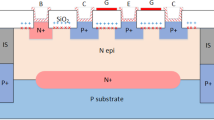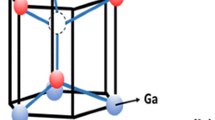Abstract
Ionizing particles and radiation may play an important, albeit undesirable role in the processing of VLSI and ULSI circuits in that they can generate bulk charge in the gate insulator of IGFETs. In this regard, there is conflicting information in the literature on the effects of ionizing radiation on short channel phenomena in IGFETs. For example, Peckeraret al. in 1983 claimed that the effective channel length increases when positive coulombic charge is introduced during irradiation, resulting in a decrease in the short channel effect. Schrankleret al. in 1985 claimed in an experimental study, on the other hand, using 28.0 nm thick gate oxides and 0.9–10 μm channel lengths, that the effect is increased,i.e., the short channel effect begins at longer channel lengths. Wilson and Blue in 1982, in a theoretical study concluded that other than a uniform downward shift in theV T -channel length curve due to the presence of insulator net fixed positive charge, no effect should be observed. Because of these conflicting reports, it was decided to evaluate this behavior using two different background doping levels inn-channel structures, with physical channel lengths ranging between 1.5 and 10 μm, in 0.1 and 0.5 gWcm (100) Si. To further explore the situation, gate oxide (grown at 1000° C in O2 containing 4.5% HC1) thicknesses were varied from 17.0–35.0 nm, and the absorbed radiation dose using Al-Kα (1.5 keV) x-rays was varied between 2.4 × 106 rad (SiO2) and 2.4 × 107 rad (SiO2). For all conditions studied above, a uniform downward shift in the VT-Channel length curve was observed, essentially corroborating the theoretical conclusions of Wilson and Blue. In addition to the above, the effects of intentionally doping the gate insulator with boron (1.2 × 1012 B+ cm−2) implanted at 8 and 10 keV into 25.0 nm and 31.4 nm oxides, respectively, on short channel effects were evaluated for devices grown onp-type 0.5 Ω.cm substrates. Unlike the devices which did not have excess boron intentionally implanted into the gate insulator, it was found that higher concentrations of boron (2.0 × 1017 cm−3 in the insulator via implantation as compared to 4.2 × 1016 cm−3 incorporated in oxides during the oxide growth on 0.5 Ω.cm type (100) Silicon) leads to smaller short channel effects in unirradiated devices. On the other hand, these heavily doped oxides show a distinct worsening of the short channel effect after exposure to 2.4 × 107 rad (SiO2) using Al-Kα radiation. Thus, while normal devices exhibit little if any short channel improvement, or degradation following irradiation, intentionally doped insulators show an improvement in short channel characteristics prior to irradiation, and a worsening of the short channel effect following irradiation.
Similar content being viewed by others
References
A. Reisman, Proc. Symp. Thin Dielectrics, Electrochemical Soc. Oct. 9–14 (1988).
C. M. Osburn and A. Reisman, J. Supercomputing1, 149(1987).
A. Reisman, Proc. IEEE71, 550 (1983).
D. L. Critchlow, R. H. Dennard and S. E. Schuster, IBM J. Res. Develop.17, 430 (1973).
A. S. Grove and D. J. Fitzgerald, Solid-State Electron.9, 783(1966).
G. T. Cheney and R. A. Kotch, Proc. IEEE56, 887 (1968).
R. C. Varshney, Electron. Lett.9, 600 (1973).
H. S. Lee, Semiconductor Silicon, Elect. Chem. Soc. 791 (1973).
H. S. Lee, Solid-State Electron.16, 1407 (1973).
L. D. Yau, Solid-State Electron.17, 1059 (1974).
K. O. Jeppsson, Electron. Lett.11, 297 (1975).
K. E. Kroell and G. K. Ackermann, Solid-State Electron.19,77 (1976).
R. R. Troutman and A. G. Fortino, IEEE Trans. ElectronDevicesED-24, 1266 (1977).
P. P. Wang, IEEE Trans. Electron DevicesED-25, 779 (1978).
W. Fichtner and H. W. Potzl, Int. J. Electron.46, 33 (1979).
G. W. Taylor, IEEE Trans. Electron. DevicesED-25, 337(1978).
T. Toyabe and S. Asai, IEEE Trans. Electron DevicesED-26, 453 (1979).
L. A. Akers and J. J. Sanchez, Solid-State Electron.25, 621(1982).
J. R. Brews, W. Fichtner, E. H. Nicollian and S. M. Sze, IEEE Trans. Electron Device Lett.EDL-1, 2 (1980).
L. A. Akers, Solid-State Electron.24, 621 (1981).
L. A. Akers and J. J. Sanchez, Solid-State Electron.25, 621(1982).
M. C. Peckerar, D. B. Brown, H. C. Lin and D. I. Ma, IEEE Trans. Electron DevicesED-30, 1159 (1983).
J. W. Schrankler, R. K. Reich, M. S. Holt, D. H. Ju, J. S. Hwang, G. D. Krichner and H. L. Hughes, IEEE Trans. Nucl. Sci.NS-32, 3988 (1985).
C. L. Wilson and J. L. Blue, IEEE Trans. Nucl. Sci.NS-29,1676 (1982).
J. Y. Chen, R. Martin and D. O. Patterson, IEEE Trans. Nucl. Sci.NS-29, 1059 (1982).
A. Reisman, C. J. Merz, J. R. Maldonado and W. W. Molzen,J. Electrochem. Soc.131, 1404 (1984).
J. Y. Chen, R. C. Henderson, R. Martin and D. O. Patterson, IEEE Trans. Nucl. Sci.NS-29, 1681 (1982).
A. Reisman, C. K. Williams and J. R. Maldonado, J. Appl. Phys.62, 868 (1987).
P. K. Bhattacharya, A. Reisman and M. C. Chen, J. Electron. Mater.17, No. 4, 273 (1988).
C. K. Williams, A. Reisman, P. Bhattacharya and W. Ng, J. Appl. Phys.64 1145 (1988).
T. H. Ning and H. N. Yu, J. Appl. Phys.45 5373 (1974).
Author information
Authors and Affiliations
Rights and permissions
About this article
Cite this article
Bhattacharya, P.K., Reisman, A. A study of x-ray damage effects on the short channel behavior of IGFET’s. J. Electron. Mater. 19, 727–732 (1990). https://doi.org/10.1007/BF02655241
Received:
Revised:
Issue Date:
DOI: https://doi.org/10.1007/BF02655241




